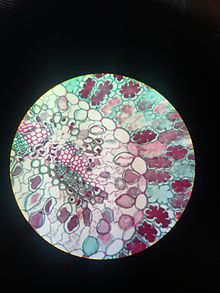You can help expand this article with text translated from the corresponding article in French. (February 2019) Click for important translation instructions.
|

(blue: Xylem, green: Phloem, white: Cambium)
A concentric, periphloematic(Hadrocentric)
B concentric, perixylematic(Leptocentric)
C radial with inner xylem, here with four xylem-poles, left closed, right open
D collateral closed
E collateral open
F bicollateral open




A vascular bundle is a part of the transport system in vascular plants. The transport itself happens in the stem, which exists in two forms: xylem and phloem. Both these tissues are present in a vascular bundle, which in addition will include supporting and protective tissues. There is also a tissue between xylem and phloem, which is the cambium.
The xylem typically lies towards the axis (adaxial) with phloem positioned away from the axis (abaxial). In a stem or root this means that the xylem is closer to the centre of the stem or root while the phloem is closer to the exterior. In a leaf, the adaxial surface of the leaf will usually be the upper side, with the abaxial surface the lower side.
The sugars synthesized by the plant with sun light are transported by the phloem, which is closer to the lower surface. Aphids and leaf hoppers feed off of these sugars by tapping into the phloem. This is why aphids and leaf hoppers are typically found on the underside of a leaf rather than on the top. The position of vascular bundles relative to each other may vary considerably: see stele. The vascular bundle are depend on size of veins
 Cross section of a leaf showing parts of a vascular bundle
Cross section of a leaf showing parts of a vascular bundle
Bundle-sheath cells
The bundle-sheath cells are the photosynthetic cells arranged into a tightly packed sheath around the vein of a leaf. It forms a protective covering on the leaf vein and consists of one or more cell layers, usually parenchyma. Loosely-arranged mesophyll cells lie between the bundle sheath and the leaf surface. The Calvin cycle is confined to the chloroplasts of these bundle sheath cells in C4 plants. C2 plants also use a variation of this structure.
References
- Sage, Rowan F.; Khoshravesh, Roxana; Sage, Tammy L. (1 July 2014). "From proto-Kranz to C4 Kranz: building the bridge to C4 photosynthesis". Journal of Experimental Botany. 65 (13): 3341–3356. doi:10.1093/jxb/eru180. PMID 24803502.
Further reading
- Campbell, N. A. & Reece, J. B. (2005). Photosynthesis. Biology (7th ed.). San Francisco: Benjamin Cummings.
External links
- Curtis, Lersten, and Nowak cross section of a vascular bundle
- Mauseth another cross section of a vascular bundle
| Botany | |||||||||||
|---|---|---|---|---|---|---|---|---|---|---|---|
| Subdisciplines | |||||||||||
| Plant groups | |||||||||||
| Plant anatomy |
| ||||||||||
| Plant physiology Materials | |||||||||||
| Plant growth and habit | |||||||||||
| Reproduction | |||||||||||
| Plant taxonomy | |||||||||||
| Practice | |||||||||||
| |||||||||||